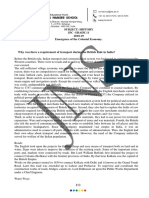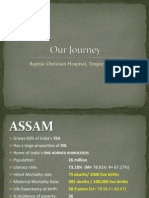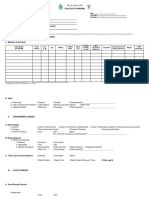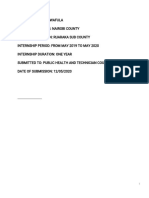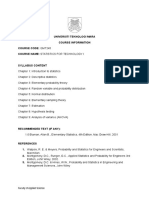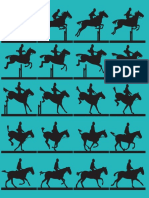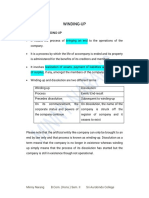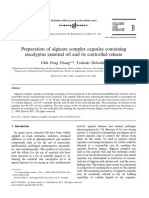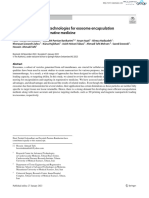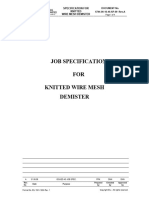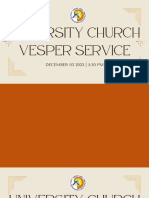COMMUNITY INTERNSHIP REPORT CHAPTER 4 (Repaired) - 1
Uploaded by
shang ExodusCOMMUNITY INTERNSHIP REPORT CHAPTER 4 (Repaired) - 1
Uploaded by
shang ExodusDEDICATION
THIS PIECE OF WORK IS
DEDICATED TO OUR
SPONSORES WITH LOTS OF
LOVE FOR THEIR SUPPORT.
1
ACKNOWLEDGEMENT
Our thanks goes to the following;
. God almighty for his grace and guidance throughout our community studies.
. To the director and the entire staff of FLENSHIHBs.
. To the matron and staff of The Martins Medical Center.
. To my classmates for team spirit in the field.
. To the entire Nkwen community for cooperation.
2
LIST OF THE ABBREVIATION
ANC: Antenatal Clinic
IWC: Infant Welfare Clinic
CRP: Creatinine Reaction Protein
HB: Haemoglobin
MUAC: Middle Upper Arm Circumference
OPD: Out Patient Department
CHW: Community Health Workers
CHN: Community Health Nurses
HAMC: Health Area Management Committee
FBS: Fasting Blood Sugar
VS: Vaginal Smear
UTI: Urinary Tract Infection
LLINs: Long Lasting Insecticide Treated
VDRL: Venereal Diseases Research Laboratory
DPT: Diphtheria Pertussis Tetanus Vaccine
BCG: BacilliChalmette Guerin
STDs: Sexually Transmittable diseases
FBC: Full Blood Count
AB: Abortion
TMCMC: The Martins Catholic Medical Center
FLENHIHBs: Florence Nightingale Higher Institute of Healthy and Biomedical Sciences
3
TABLE OF CONTENTS
Contents
DEDICATION................................................................................................................................................1
ACKNOWLEDGEMENT.................................................................................................................................2
LIST OF THE ABBREVIATION.........................................................................................................................3
TABLE OF CONTENTS...................................................................................................................................4
CHAPTER ONE..............................................................................................................................................4
1.1 INTRODUCTION.....................................................................................................................................6
1.2 INTERNSHIP OBJECTIVES........................................................................................................................6
1.3 CLIMATE VEGETATION AND TOPOGRAPHY........................................................................................3
1.3.1 CLIMATE.............................................................................................................................................3
1.3.2 VEGETATION.......................................................................................................................................3
1.3.3 TOPOGRAPHY....................................................................................................................................3
1.4 HISTORY OF THE PEOPLE OF NKWEN.................................................................................................3
1.5 SOCIO-ECONOMIC ACTIVITIES OF THE PEOPLE OF NKWEN...............................................................3
1.6 CULTURE OF THE PEOPLE OF NKWEN:............................................................................................4
1.7 TABOOS:..............................................................................................................................................5
1.8 ADMINISTRATION:..............................................................................................................................5
CHAPTER TWO.............................................................................................................................................7
DESCRIPTTION OF THE MARTIN’S HEALTH AREA AND MEDICAL CENTRE....................................................7
2.1 DESCRIPTION OF THE HEALTH AREA.....................................................................................................7
2.2 DECRIPTION OF THE HEALTH CENTER................................................................................................7
2.4 STAFFING AND ORGANIZATION OF THE HEALTH AREA......................................................................9
2.5 ACTIVITIES OF THE MARTIN’S CENTER..............................................................................................9
2.6 ACTIVITIES CARRIED OUT BY STUDENTS IN THE HEALTH CENTER..................................................10
2.7 ORGANIZATION OF THE HEALTH INSTITUTION OF THE MARTIN’S NKWEN......................................11
CHAPTER THREE........................................................................................................................................12
3.1 ORIENTATION OF PRIMARY HEALTH CENTER..................................................................................12
DIALOGUE STRUCTURE..............................................................................................................................12
4
3.2 THE MANAGEMENT COMMITTEE...................................................................................................12
3.3 CO-FINANCING.................................................................................................................................12
3.4 PROBLEMS FACED AT THE MARTIN’S HEALTH CENTER.....................................................................12
3.5 SOLUTIONS TO THE PROBLEM.........................................................................................................13
CHAPTER FOUR..........................................................................................................................................14
4.1 VIST TO THE HEAD QUARTER OF NTAMUCHE...................................................................................14
4.2 HOME VISITS...................................................................................................................................14
4.3 VISIT TO THE WATER CATCHMENT...................................................................................................16
4.4 WASTE MANAGEMENT IN THE HOSPITAL.......................................................................................16
4.5 VISIT TO THE FON’S PALACE.............................................................................................................18
4.6 VISIT TO THE SLAUTER HOUSE........................................................................................................18
4.7 VISIT TO THE NEW ACEDEMIC NURSERY AND PRIMARY SCHOOL.................................................19
4.8 VISIT TO THE CHURCH.....................................................................................................................19
4.9 VISIT TO THE MARKET..................................................................................................................20
CHAPTER FIVE...........................................................................................................................................21
5.1 CONSULTATION STATISTIC IN THE COMMUNITY............................................................................21
5.1.0 STATISTICS IN THE MARTIN’S HEALTH CENTER RECORD............................................................21
5.1.1 STATISTICS ON DELIVERY RECORD..............................................................................................21
5.1.2 CONSULTATION STATISTICS FOR WOMEN WHO ATTENDED ANC FROM ANC RECORDS............22
5.2 COMMON DISEASES.....................................................................................................................22
5.4 DISEASE SURVEILLANCE...................................................................................................................22
5.4.1 SOME DEFINITIONS......................................................................................................................23
5.5 COMMUNITY DIAGNOSIS.................................................................................................................23
5.6 PROPOSED SOLUTION.....................................................................................................................23
CHAPTER SIX.............................................................................................................................................23
6.1 RECOMMENDATIONS........................................................................................................................24
6.2 CONCLUSION..................................................................................................................................25
CHAPTER ONE
5
1.1 INTRODUCTION
Public Health according to WHO
Definition
Health is a state of complete physical, mental and social wellbeing of an individual not
merely the absence of disease or infirmity.
Community health nursing entails paying more attention to nursing service in the
community as a whole.
Definition by ANC
Community health nursing is the synthesis of nursing practice and public health practice
applied in promoting and presenting the health of the population.
Community by WHO
Community Health Nursing is defined as a field of nursing practice and relayed skills,
which is applied in meeting the health needs in individuals, families and communities in their
environment such as home, school and place of work.
COMMUNITY
Definition
A community is a group with geographical boundaries having common values and interest its
members know and interact with each other. It functions with a particular structure and exhibits
certain norms, values, and social institutions.
COMMUNITY HEALTH
Definition
It refers to the health status of the members of the community to the problem affecting their
health and to the totality of health care provided to the community.
The main purpose of this report is to give a details account of the activities we carried out
from the 04 to the 29 of October, 2023 in The Martins Health Center.
1.2 INTERNSHIP OBJECTIVES
6
The internship was for one month. We had the following objectives.
1) Identify, with brief description, the health district, health area, health center (structure,
unit, equipment, staffing) dialogue structure. Management and financial structure of the
health center all within the Framework of Reorientation of Primary Health Care.
2) Plan and organize health center activities on a daily, weekly and monthly bases.
3) Participate actively in the implementation and evaluation of the above health center
activities.
4) Identify and outreach clinic and participate in its activities within the framework of PHC.
5) Carryout a community health study with focus on community diagnosis and the health
plan of action based on available local resources.
6) Produce a written group report, which will be presented in the school at the end of the
field experience.
Method of Attainment of Objectives
7) During the four week’s students must stay permanently at the health center.
8) Work in all units (rotation time-table).
9) Carryout planned visits to homes, institutions in the community (for example Fon’s
Palace, Churches) and interact freely with local leaders, community authority’s family
heads and school authorities.
10) Visits to schools, markets, slaughter house water points refuse or sewage disposal sites
etc.
11) Visit at least one outreach clinic.
12) While at the health center, use all resources at your disposal for example, health center
staff, consultation of health center statistics record and report.
13) Work as an organized group, depends on and help each other
7
1.3 CLIMATE VEGETATION AND TOPOGRAPHY
1.3.1 CLIMATE
It is de average weather in a given area at a particular period of time. Nkwen has a tropical
savanna climate, with a long summer and wet season and considerably less rainfall. The rainy
season starts from March to October, While the dry season starts from November to February.
1.3.2 VEGETATION
It is and assemblage of plant species and the ground cover they provide. The vegetation of
Nkwen is a grassland type and the land is used for mixed cropping (maize, groundnut, beans,
vegetables, yams).
1.3.3 TOPOGRAPHY
It is the study of the forms and features of land surfaces. Nkwen is a suburb in Cameroon and
has an elevation of 1,259 meters. Nkwen has few streams which run across the village and few
waterfalls,which help with the supply of water in the area.
1.4 HISTORY OF THE PEOPLE OF NKWEN
The people of Nkwen migrated from from Sudan about 700 yers ago. They migrated from
Nso to Kom to Bafu to Beriwa(because of a dispute), from there they settled in Atielah and in
which the queen mother Mai Awa Fezang later on went to fetch water and discovered that there
was a low lying area, where she went back and informed the community in the hilly area. They
moved from the hills that is Atielah to the present settlement today.
Six fons have ruled from then to present; Three Fon Ngufor’s and three Fon Azefor’s, with
the existence of the present fon named Fon Azefor the 3 who took over from Fon Ngufor the 3
on the month of November 2013.
1.5 SOCIO-ECONOMIC ACTIVITIES OF THE PEOPLE OF
NKWEN
The main socio-economic activity agriculture, mainly subsistent agriculture, with the
cultivation of food crops such as maize, cassava, cocoyam’s beans, vegetables, groundnuts.
8
1.6 CULTURE OF THE PEOPLE OF NKWEN:
Nkwen is village made of “Country days” and “country Sundays” in which some are
small and some big. During small “country days” villagers are permitted to go to the farm but
they don’t work with tools, but their hands. While during big “country days” villagers are not
permitted to go to their farms at all.
MARRIAGE IN NKWEN:
They are three types of marrieges in Nkwen.
1. Marriage to the prince.
2. Marriage to the princess.
3. Marriage amongst commoners.
In Nkwen, a man can get married from any tribe in Cameroon and the world at large. For
a man to officially get married to a woman in Nkwen, “Knock door”. This required introducing
yourself to the woman’s family with some litters of palm oil and palm wine.
An acceptance is indicated by further introduction to uncles and aunts and further
arrangement are made for the bride depending on the family.
The bride price of Nkwen can be payed kind or cash after the traditional rights have been
performed. After that the woman becomes the man’s wife. After the traditional marriage the
couple can official go to court to obtain a marriage certificate from there they can go to church
for blessings.
TRADITIONAL MEALS:
Achu and Egusi soup.
Achu and Black soup.
Fufu corn and Vegetables (which was been brought by the neighboring village that
surrounds them).
TRADITIONAL DANCE
Bottle dance.
Mbagelum.
CUSTOMS:
It is a long established practice considered as un written law resulting for authority.
A pregnant woman should not see a mask urate“juju”.
If a person hangs his self in any compound, the compound is automatically owned by the
palace.
9
If a knife is used on some body it cannot be used to do anything again.
1.7 TABOOS:
A taboo is a ban or restriction made by social customs. The following constitute some
taboos in Nkwen land.
It’s a taboo to know anything concerning the Fon.
It’s a taboo to go to the farm on a “country Sunday”.
It’s a taboo to question the Fon.
No suicide (killing of oneself)
You should not cross a bridge with a calabash without boring a hole on it.
It I a taboo to greet the Fon without performing all traditional rights
It is a taboo to sit on the Fons throne.
It is a taboo for a woman to wear trousers to the palace.
EFFECTS OF CUSTOMS AND CULTURE ON HEALTH
POSITIVE EFFECTS
With the advent of Christianity and the changing nature of the life requirement, certain
customs and traditions have funded in its glory hence the need for some of these cultures to up
grate.
To take into consideration, the aspect of the custom that restricts the people from destroying
food crops like plantains,cocoyam’s, among others is very important as to boast the nutritional
status of the community as a whole, thus goes a long way to encourage food production.
NEGATIVE EFFECTS
The notion that if you go to the farm on a big “country Sunday” there will be abnormalities
for example hearing of voices,seeing shadows of the late Fon’s etc.
1.8 ADMINISTRATION:
Traditionally, the Fon who leads the village is answerable to”kwifor”. The princes are
directly answerable to the Fon, among which are Ndifon and Muma. For instance, the added
name concluded with the Fon’s name (Ndifor, Azefor, Muma, Azefor).
10
There are 63 quarters in Nkwen kingdom headed by sub chiefs and head quarter. Under
the government, Nkwen is a village under the Bamenda III sub-division in Mezam division
headed by the divisional officer (D.O)
1.9 POLITICS:
The people of Nkwen are actively involved in politics. There are main political parties
that dominate in the land, which are CPDM (Cameroon Peoples Democratic Movement) and
SDF (Social Democratic Front)
ADMINISTRATION OF NKWEN
KWIFON
FON
NDIFOR
SUB CHIEFS
VILLAGE COUNCIL
QUARTER HEADS
FAMILY HEADS
11
CHAPTER TWO
DESCRIPTTION OF THE MARTIN’S HEALTH AREA AND
MEDICAL CENTRE
2.1 DESCRIPTION OF THE HEALTH AREA
The Martin’s Medical Center is located in the Northwest region Bamenda mile 3 Nkwen. It
was established in 2017 and it is also a sole proprietorship based in Bamenda. The Martin’s is
situated behind “The Farmers House”just a distance of about 100m. It has 7 health zones which
are;
. Ntasen
. Ntaghem
. Menda
. Ntamuche
. Bayelle
. Sisia
. Ntenefor
. Bangshie
2.2 DECRIPTION OF THE HEALTH CENTER
It is headed by the superior general. Located in Bamenda mile 3 Nkwen. The main
building host all the health services that are maternity, medical ward, laboratory, pharmacy,
physiotherapy, ultra sound, wards and offices.
EQUIPMENTS:
The Martin’s Center has a variety of equipment’s which include;
1. Out Patient Department
- BP apparatus
- Pulse oximeter
- Thermometer
- Table
- Chair
- Benches
12
- A weighing scale
2. Nursing Station
. Table
. 3 chairs
. A cub board
. A refrigerator
. Trays BP apparatus, thermometer and pulse oximeter
3. Laboratory
. 2 tables
. Microscope
. Chairs
. Biochemistry machine
. Haematology machine
. Examination beds
. Working surfaces
. Test tubes
4. IWC and ANC hall
. 2 big tables
. Chairs
. Baby’s scale
. Safety box
5. Maternity
. Labor room
. 2 delivery beds
. Stethoscope
. tape
. suction bulb
. Table
. sink and working surface
13
. weighing scale
. 13 beds
. Bed side cupboards
6. Minor Theater
. Table
. 2 chairs
. Cupboard
. 2 examination beds
. A sink
. A bucket
2.4 STAFFING AND ORGANIZATION OF THE HEALTH AREA
The Martin’s Medical Center consist of the following staff
The Matron
15 nurses
3 doctors
5 laboratory technicians
4 cleaners
10 midwifes
4 pharmacist
2 cashiers
2 security guards
Finance personnel
2.5 ACTIVITIES OF THE MARTIN’S CENTER
Daily activities include:
Morning devotion.
Daily consultation of patients from 7:30am to 3:00pm.
Baby’s bath and circumcision in the maternity.
14
Wound dressing, administration of drugs, washing and sterilization of equipment’s.
Laboratory examination such as urinalysis, PT, MP, stool, MIDA, FBC, CR proteins.
Bed making, cleaning and assessment of vital signs.
WEEKLY ACTIVITIES
Morning Mass every Wednesday
Booking clinic
Infant welfare clinic
Antenatal clinic
OP on Wednesdays and Fridays, except in case of an emergency
MONTHLY ACTIVITIES
Statistics
Dialogue structure meetings
Outreach to various quarters
YEARLY ACTIVITIES
End of year meetings, where evaluated and sent to the health district.
2.6 ACTIVITIES CARRIED OUT BY STUDENTS IN THE
HEALTH CENTER
General cleaning.
Monitor and record vital signs.
Bed making.
Drug administration.
Assist in the laboratory for collection of samples and also carry out some laboratory test
such as MP and TM.
Wound dressing.
Assist in ANC.
Assist in infant welfare clinic.
Assist in delivery.
15
2.7 ORGANIZATION OF THE HEALTH INSTITUTION OF THE
MARTIN’S NKWEN
SUPERIOR GENERAL
SISTER IN CHARGE OF
APOSTOLATE
LOCAL SUPERIOR BURSER GENERAL
MATRON
OTHER SISTERS BURSAR OF HEALTH FACILITY
SPECIAL PROGRAM HEADS
OR HEAD OF DEPARTMEBT
STAFF DELIGATE DR IN CHARGE OF
CLINICAL
ALL TECHNICAL STAFF
DECITION
HEAD OF
DEPARTMENT
ALL SUPPORT STAFF
COMMUNITY HEALTH
WORKERS
16
ALL TECHNICAL ALL SUPORT STAFFS
STAFF(DOCTORS, (CLEANERS IN THE
NURSES, LABORATORY WARDS, YARDS,
TECHNICIAN) GUARDS,
MESSENGERS)
CHAPTER THREE
3.1 ORIENTATION OF PRIMARY HEALTH CENTER
DIALOGUE STRUCTURE
Definition
This is organs and forums which are put in place to enhance the following;
Effective community participation in the health care.
Communication between the health staff and community.
Partnership between the staff and community represented by users
3.2 THE MANAGEMENT COMMITTEE
It comprises of community members, the superior general, the sister in charge of apostolate and
the matron and the bursar who participate in management of resources and finances to ensure
transparency and smoot running of the health center,
They hold meetings every first week of the month to Discuss on problems and how to
solve the problem.
3.3 CO-FINANCING
It consists of the sisters of St Thereseand the community.
A) Saint Therese
They provide essential drugs.
Take into consideration the running of the health center.
Set up the health structure.
B) The Community
Consultation fees.
Nursing care fees.
17
3.4 PROBLEMS FACED AT THE MARTIN’S HEALTH CENTER
Some of the problems faced in the hospital are as follows;
In adequate BCG vaccination.
Inadequate finance to pay the staff
Problem of space.
Complains coming from patients due to high bills.
Problem of low turnout.
Problem of referral.
3.5 SOLUTIONS TO THE PROBLEM
To increase the supply of BCG.
To explain to the patients why the bills are high and make them know that they are
not being exploited
18
CHAPTER FOUR
VISITS
This is period during our internship in the Martin’s mile 3 Nkwen, in which we intern’s
move out of the health center and go into the community. In so doing they will interact with
people, identify health problem, educate the population about their health and propose possible
solution to the problem identified.
4.1 VIST TO THE HEAD QUARTER OF NTAMUCHE
On the 25-10-2023 we visited the quarter head of Ntamuche, later on to Bayelle and.
The Ntamuche head quarter residents situated 100m from St Paul’s college at mile 3 along
leading from mile 3 to the Bamenda 3 council.
We went with the following objectives;
To ask for his permission to carry out home visits in his area.
To fine out his role performed in promoting health in his community.
On arrival we were welcomed by his brother, which later informed him of our presents,
and he came to us within a short time. We presented our objectives to him, which he took it,
appreciated our presents and gave the go ahead to go on with the home visits and to inform
him of every problem if it arises.
4.2 HOME VISITS
We visited a total of 125 houses in 2 zones which where Ntamuche, Bayelle. We were
accompanied by a community health staff of the health center with the following objectives;
To asses on the hygienic conditions of the latrines.
To educate them on proper hand washing.
Ensure proper use of LLINS.
Asses on environmental hygiene.
To educate the family on family planning.
To educate them on the health problems identified and propose possible method s of
preventing them.
To know how they dispose of their waste and how far the do it.
19
to give remedy and solution to any problem the face.
PROBLEMS
Dirty surroundings.
Not well constructed latrines with no leads doors and roof.
PROPOSED SOLUTION
To clean their surroundings and provide lids for the latrines.
Close doors and windows before 5pm.
Select waste and plastics burned.
STARTISTICS FOR HOME VISITS
Ntamuche Ntamuche Bayelle, 31 Bayelle, 20
Objectives Parameters 22 houses. 27 houses. houses. houses.
1st visit 2nd visit rd
3 visit 4th visit
Quality of the Present 100% 100% 100% 100%
toilet Absent 0% 0% 0% 0%
Clean 65% 30% 70% 60%
Dirty 35% 10% 30% 40%
Water source Tap 35% 80% 90% 90%
Other 65% 20% 10% 10%
sources
Availability and Presents
use of LLINS and good 70% 90% 25% 65%
use
Present and 15% 4% 60% 30%
poorly use
Absent 15% 6% 5% 5%
Refuse disposal Farm 95% 65% 90% 30%
Pit 0% 35% 10% 18%
Stream 5% 0% 0% 2%
Knowledge of the Knowledge 50% 80% 55% 65%
family planning No 50% 20% 45% 55%
knowledge
Vaccination Complete 75% 95% 60% 55%
Still to 25% 5% 40% 90%
complete
Knowledge of knowledge 90% 90% 40% 65%
hand washing No 10% 20% 60% 10%
knowledge
Environment Clean 45% 45% 60% 90%
Dirty 55%% 55% 60% 35%
20
Visits 1st visit 2nd visit 3rd visit 4th visit
Number of
homes 22 27 31 20
TOTALS: 100
4.3 VISIT TO THE WATER CATCHMENT
On Thursday the 12\10\2023. We visited the water catchment, accompanied by the
community health staff of The Martin’s Health Center and technician given to us by the mayor.
We went with the following objectives;
To locate its site.
To asses on hygiene.
To know how the catmint is channel to the treatment center.
The water catchment is an area where water is collected by natural land scope. The water
catchment is located in Menteh quarter found in Nkwen and its treatment center is some
kilometers away from it. Filtration begins at the catchment that is from trapping of leaves and
sticks from entering the pipe to the movement of water by velocity to the pipes and down to the
treatment site.
TREATMENT SITE
The technician took all of us to the filtration site, where he explains to us the various stages
of purification and how its carried out.
They exist 3 filters with 2 pressure bars which indicates the pressure of the water at top
and bottom of the. They exist 2 reservoirs in which the big reservoir has a capacity of
800000 litters and the smaller one with a capacity of 400000 litters. Treatment is done
every day, with calcium sulphate and chlorine. General cleaning is done after 3 months.
PROBLEMS
Not enough supply to all quarters.
RECOMMENDATION
A sup water tank should be built in those quarters.
4.4 WASTE MANAGEMENT IN THE HOSPITAL
Waste management in The Martin’s Health Center is one of the best if not the best, which
help to increase on their hygienic and sanitation. Staff work in collaboration with the cleaners.
The Cleaners
21
They clean the floor twice everyday, empty the trash bins every day (The maternity and
laboratory is cleaned by the staff who work there).
Placenta’s are being emptied in the placenta bin behind the hospital.
The bed sheets are being washed and ironed before use.
How Trash Bins Are Positioned for Waste Disposal
From the entrance of the gate, there exist about 7 trash cans, extending from the OPD to
the canteen.
While the corridor in the first floor has another line of trash cans which are 4 in number
and the second floor and all other departments which have enough trash bins.
For the patients and careers, they have both the wet and try bins. While the nursing
station, maternity lab and theater has the wet, dry, safety box and a box for the vails,
which assist the cleaners with disposal.
All this waste management helps to prevent nosocomial infections and promote
hygiene and sanitation. The sorting of infectious waste can be seen below.
INFECTIOUS
WASTE
Infectious Sharp Box for Liquid Expired
waste waste vials infections drugs
Latrine and trash
incinerator
Placenta pit
22
GENERAL WASTE
PROBLEMS
. The placenta pit is too close to the community and hospital and almost full.
PROPOSED SOLUTION
. A different pit should be dug far away from the community and hospital.
4.5 VISIT TO THE FON’S PALACE
On Saturday the 18\10\2023. We visited the Nkwen Fon’s palace,accompanied by the
community health worker and welcome by the notables. After which we were later sent to meet
the Fon with us having the following objectives;
To locate the site of the palace.
To fine out the hygienic conditions of the palace.
To obtain the history of Nkwen.
To know the cultures and tradition.
To know the taboos.
To identify how they marry and find out their traditional meals.
The palace of Nkwen is located in center pole closest to the mile 4 health center. On
arrival, we introduced our selves to the Fon with his permission and in which he told us of
their history, which was more of migration, their culture and tradition, taboos, meals and
how they get married. The visit ended with an advice from the Fon to us.
4.6 VISIT TO THE SLAUTER HOUSE
On Wednesday the 27\10\2023. We visited the slaughter house, accompanied by
the community health worker of the Martin’s hospital. We went there with the following
objectives;
To fine out on their hygienic conditions.
To educate them on hygiene.
23
To fine out and advice the workers on the food preservative methods.
The slaughter house is located in mile 4 Nkwen behind Nso Boyz travelling
agency. We arrived at the slaughter house at the early hours of the morning in other to observe
everything that happened there. We were welcomed by the manager who showed us around and
told us of how the slap is being operated. We observed the cleaning of the slaughter house after
the cattle’s where slaughtered. We later on advised them on the importance of hygiene and how
it can help them individually and buyers.
4.7 VISIT TO THE NEW ACEDEMIC NURSERY AND
PRIMARY SCHOOL
On Tuesday the 25\10\2023 we visited the new academic bilingual nursery and
primary school Ntamuche accompanied by the community health staff with the following aims.
Hand hygiene.
Environmental hygiene.
The school is located in Ntamuche few km from the Bamenda III council.
Arrival we were welcome by the school head teacher, later on we educated the pupils on
environmental hygiene and lastly hand hygiene and in which we educated and did practical
work on hand hygiene and gave the opportunity for some students to demonstrate, which they
did it excellently well. We emphasized on personal hygiene, which was brushing of their
teeth’s, washing of hand and bathing twice a day.
PROBLEM
Hand washing not properly done.
Surrounding not clean.
PROPOSED SOLUTION
To practice on hand hygiene for often and bucket of water with taps be placed in every
class.
Routine cleaning of the school should be done every day by respective classes.
4.8 VISIT TO THE CHURCH
On Sunday the 22\10\2023, we visited the Rhama Christian Center, accompanied by
the community health work with the following aims;
To educate the congregation on the prevention against common diseases like COVID 19,
Prostate cancer
24
To educate the church on the health advantages of physical activities.
To health educate the congregation on environmental and personal hygiene.
The Rhama center is located few km away from the Bamenda III council closest to New
Academic school. We attended mass and was later on introduced by the pastor to the church.
We educated them on monkey pox and Hep-b, personal hygiene, environmental hygiene.
The visit was concluded with questions from the pastor, which we answered and receive
advises from the pastor and lastly blessing.
4.9 VISIT TO THE MARKET
On Saturday the 21\10\2023, we visited the market which is located at Doctor
Mondi at mile 2 Nkwen New Road, leading to up station with the following objectives;
To fine out the hygienic conditions of the market premises.
To locate where waste is disposed off
To educate food venders on the vitals of washing drinking cups after each customer to
avoid cross infection.
To Identify their source of drinking water.
To educate food sellers to wash fruits before selling to customers for consumption.
To fine out the hygienic conditions of the toilets.
We all achieved with the collaboration of the marketers.
PROBLEM IDENTIFIED
Poor waste disposal producing bad odor.
Poor usage of toilet.
PROPOSE SOLUTION
The users of the market toilet should be educated to clean before and after use.
The council should provide trash cans in the market.
25
CHAPTER FIVE
5.1 CONSULTATION STATISTIC IN THE COMMUNITY
5.1.0 STATISTICS IN THE MARTIN’S HEALTH CENTER
RECORD
Disease August September October Totals
. Malaria 50 47 55 152
. Typhoid 15 24 27 66
fever
. Gastritis 10 22 08 30
. Appendicitis 07 05 12 24
. Diarrhea 05 03 10 18
. 08 04 11 23
Hypertension
. Hepatitis 09 05 02 16
. Bacterial 18 10 05 33
Infection
. Rheumatism 30 25 34 89
From the statistics above we had 152 malaria cases, 66 typhoid cases of gastritis, 23
cases of hypertension, 16 cases of hepatitis, 33 cases of bacterial infection and 89 cases of
Rheumatism.
5.1.1 STATISTICS ON DELIVERY RECORD
Delivery Cases October September Total number
. Normal deliveries 64 70 134
. Deliveries 13 10 23
. Premature 00 00 00
. Still births O1 00 01
. HIV Mothers 01 00 01
From the above statistics, 134 babies were delivered normally, 23 through operation and
one still birth, one HIV positive mother and no premature delivery.
26
5.1.2 CONSULTATION STATISTICS FOR WOMEN WHO
ATTENDED ANC FROM ANC RECORDS
Visits Number of women who went for visit in
October
First visit 11
Second visit 71
Third visit 14
Fourth visit 21
Fifth visit 28
TOTAL: 145
The above statistics show that; 11 women went for the 1 visit, 71 for 2 visit, 14 for third visit, 21
for 4 visit and lastly 28 for 5 visit. Leading to a total of 145.
5.2 COMMON DISEASES
The common disease we had seen during our stay in the community include;
Malaria
Typhoid
Gastritis
Diarrhea
Rheumatism
Hepatitis
Appendicitis
Hypertension
Bacterial infections
5.4 DISEASE SURVEILLANCE
These are the immediate action put in place in order to prevent the spread of disease.
The healthcenter also carried out disease surveillance on the following diseases;
Tuberculosis
Measles
Poliomyelitis
Yellow fever
27
5.4.1 SOME DEFINITIONS
1) Tuberculosis
A bacterial infection spread through inhaling tiny droplets from cough or sneeze of
and infected person. Its signs and symptoms are coughing of blood or mucus chest pain, fatigue,
fever, night sweat, weight less.
2) Measles
Its and acute viral respiration illness. Its signs and symptoms are high fever, cough,
running nose and watery eyes. Its symptoms will appear 7 to 14 days after contact with the virus.
3) Poliomyelitis
It is cause by the polio virus. Its signs and symptoms are fatigue, muscle wasting, difficulties in
breathing and swallowing, difficulties in sleeping.
4) Yellow Fever
It is caused by the bite of infected mosquitoes. It is characterized by sudden onset of fever,
severe headache, back pain, general body aches, nausea, vomiting, fatigue and weakness.
5.5 COMMUNITY DIAGNOSIS
Community diagnosis is the process of identifying community health problem,
uncovering their root causes and developing a clear plan to overcome them. The diseases
common in the community during our visit include;
Malaria
Typhoid fever
Gastritis
Hypertension mostly in older people
5.6 PROPOSED SOLUTION
- Education of the population how to keep their water free from contaminants.
- Educate the population on how to use mosquito nets and their importance.
- provision of mosquito nets for those that do not have.
- Educate the population on the causes of hypertension and how to prevent it.
CHAPTER SIX
28
6.1 RECOMMENDATIONS
The given period of internship helped us to observe practice and implement theoretical
knowledge and new skills, given to us in school and also what we derived from the staff of The
Martins Health Center. During this period, we recognized the following draw back in the health
center and community as a whole.
The placenta pit is too close to the community and almost full.
Many homes not having lids in their toilet.
Pits are too close to homes, with no sorting of dirt.
They wasn’t any outreach program this year
From the above the following proposals where made
For the placenta and home pits to be dogged far away from the hospital and homes.
For the toilets to be covered after use to avoid the spread of diseases.
Above these, everything was good especially in the hospital, with aseptic techniques well
done and bed making every day.
TIME TABLE
04\10\2023 05\10\2023 06\10\2023 07\10\2023
OPD OPD OPD OPD
MATERNITY MARTERNITY MATERNITY MATERNITY
NURSING NURSING NURSING NURSING
STATION STATION STATION STATION
LABORATORY LABORATORY LABORATORY LABORATORY
08\10\2023 9\10\2023 10\10\2023 11\10\2023
OPD OPD OPD OPD
MATERNITY MATERNITY MATERNITY MATERNITY
NURSING NURSING NURSING NURSING
STATION STATION STATION STATION
LABORATORY LABORATORY LABORATORY LABORATORY
12\10\2023 13\10\2023 14\10\2023 15\10\2023
Visit to the water OPD OPD OPD
point MATERNITY MATERNITY MATERNITY
NURSING NURSING NURSING
STATION STATION STATION
LABORATORY. LABORATORY LABORATORY
17\10\2022 18\10\2022 19\10\2022 20\10\2022
Visits to homes in Visit to homes in Visit to the palace Visit to homes in
Ntamuche. Bayelle. and slaughter house. Bayelle.
21\10\2022 22\10\2022 23\10\2022 24\10\2022
OPD Visit to the market Visit to Rama church OPD
29
NURSING of Ntamuche MATERNITY
STATION NURSING
MATERNITY STATION
LABORATORY MATERNITY
25\10\2022 26\10\2022 27\10\2022 28\10\2022
Visit to the school Visit to the OPD Visit to homes in
and the mayors of catchment NURSING Nkwasi
for the permission. STATION
MATERNITY
LABORATORY
29\10\2022
OPD
MATERNITY
NURSING
STATION
LABORATORY
6.2 CONCLUSION
Our community internship experience carried out in Nkwen and The Martin’s
health center was successful and very interesting, because we gathered a lot. Community
participation was excellent despite some difficulties faced, it was a success to a greater
extend. Our passing through this community will be remembered in good faith and hope
the community will implement what they gathered and gained from us.
We sincerely apologize for every negative conducts and promise to add in our
efforts and be hard working in other to be intellectual future nurses.
30
You might also like
- HISTORY ISC GRADE 11 2018-19 Emergence of The Colonial Economy. Why Was There ANo ratings yetHISTORY ISC GRADE 11 2018-19 Emergence of The Colonial Economy. Why Was There A13 pages
- Tehcnical Paper: Calculating Freezing Times in Blast and Plate Freezers by Dr. Andy Pearson100% (2)Tehcnical Paper: Calculating Freezing Times in Blast and Plate Freezers by Dr. Andy Pearson36 pages
- Annex+A-2 Draft+Amended+Net+Metering+AgreementNo ratings yetAnnex+A-2 Draft+Amended+Net+Metering+Agreement5 pages
- Boracay Rehabilitation: Case Study Analysis " "100% (1)Boracay Rehabilitation: Case Study Analysis " "4 pages
- Makerere University College of HealthsciencesNo ratings yetMakerere University College of Healthsciences43 pages
- Introduction To Public Health' - 073313No ratings yetIntroduction To Public Health' - 073313173 pages
- Christianity As A Double-Edged Sword in Colonial AfricaNo ratings yetChristianity As A Double-Edged Sword in Colonial Africa12 pages
- Classification of Lung Sounds Using CNNNo ratings yetClassification of Lung Sounds Using CNN10 pages
- REPORT Concerning The Epidemiological Standards of Kagote HC III Fortportal CityNo ratings yetREPORT Concerning The Epidemiological Standards of Kagote HC III Fortportal City39 pages
- Department of Education: Republic of The PhilippinesNo ratings yetDepartment of Education: Republic of The Philippines3 pages
- Advanced Micro :nanotechnologies For Exosome Encapsulation and Targeting in Regenerative MedicineNo ratings yetAdvanced Micro :nanotechnologies For Exosome Encapsulation and Targeting in Regenerative Medicine22 pages
- Community Health Assessment Hibret KebeleNo ratings yetCommunity Health Assessment Hibret Kebele24 pages
- STP32537S Characterization of High Purity Cathodes For Plant ControlNo ratings yetSTP32537S Characterization of High Purity Cathodes For Plant Control30 pages
- Comprehensive Gened Booster 1 QuestionnaireNo ratings yetComprehensive Gened Booster 1 Questionnaire26 pages
- From A Game of Polo With A Headless Goat-AnnotatedNo ratings yetFrom A Game of Polo With A Headless Goat-Annotated2 pages
- The Wilderness Effect and Ecopsychology RobertGreenwayNo ratings yetThe Wilderness Effect and Ecopsychology RobertGreenway13 pages
- 11th Physics Book Back Questions With Answers in EnglishNo ratings yet11th Physics Book Back Questions With Answers in English29 pages
- Shop Christian Louboutin Loubi Girl 100 Leather Sandals Saks Fifth AvenueNo ratings yetShop Christian Louboutin Loubi Girl 100 Leather Sandals Saks Fifth Avenue1 page
- ST Martin de Porres Catholic Hospital NjinikomNo ratings yetST Martin de Porres Catholic Hospital Njinikom55 pages
- An Attachment Health Report at Kakamega County General HospitalNo ratings yetAn Attachment Health Report at Kakamega County General Hospital19 pages


